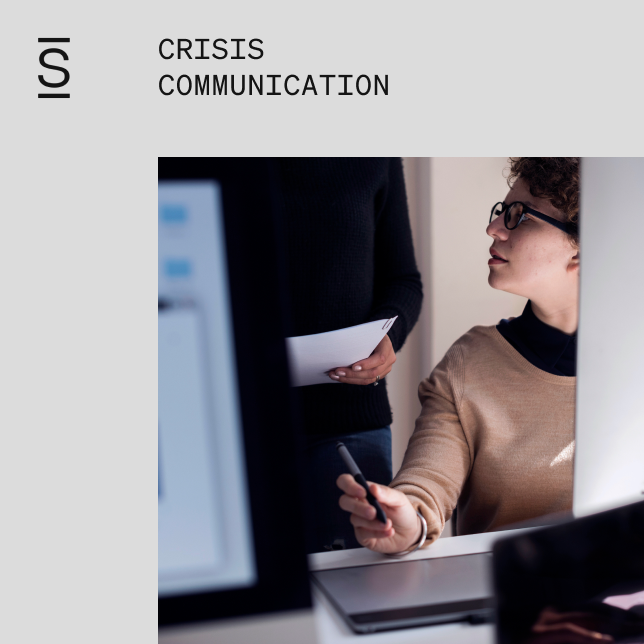Crisis communication definition
Crisis communication is the strategic practice of managing and sharing critical information during company emergencies, public issues, or unexpected events that could potentially harm an organization’s reputation or operations. The practice requires rapid, clear, and effective communication to mitigate risks, maintain trust, and ensure business continuity.

Basic introduction to crisis communication
During crises, businesses must effectively communicate with employees and external stakeholders. Crisis management teams need ways to disseminate key information to protect employees, reassure the public, and minimize negative impacts as much as possible.
To be prepared, businesses create crisis management plans that can launch a quick response to many types of crises. The nature of the potential crisis might not be known in advance, but an office of crisis management can designate a crisis communications team with clear responsibilities, create a general action plan, and organize communication channels—preparing to put the crisis plan into effect.
What is a crisis communications plan?
A crisis communications plan is a strategic framework and set of procedures that an organization develops to effectively and efficiently handle and address communication challenges and issues during a crisis. The plan outlines necessary steps and protocols for the crisis communication team to ensure timely and accurate communication with stakeholders, media, and the public. The goal of the plan is to mitigate potential damage to the organization’s reputation while maintaining trust and transparency with both employees and the public.
Real-life crisis communication examples
The following crisis communication examples demonstrate the importance of swift, transparent communication in times of crisis. By taking responsibility, implementing safety measures, and actively addressing the concerns of stakeholders, companies can effectively navigate crises and maintain their reputations. When they fail to act quickly and decisively, however, the results can be devastating.
1. BP’s crisis communication during the Deepwater Horizon oil spill
In 2010, the Deepwater Horizon drilling platform exploded in the Gulf of Mexico, leading to a massive crisis communication challenge. It took three months to fully cap the resulting oil leak, spilling some 134 million gallons of oil into the Gulf. The repercussions were severe for both the natural environment and BP’s reputation, but the company’s crisis communication strategy played a crucial role in managing the fallout.
BP took responsibility for the spill, mobilized resources for containment and cleanup efforts, provided regular updates to the public, and ultimately spent billions of dollars toward Gulf restoration projects. The company also established a claims process to compensate individuals and businesses affected by the spill. By taking ownership of the crisis and actively working toward resolution, BP was able to regain public trust and mitigate the long-term damage to its reputation.
2. Procter & Gamble’s response to the Tide Pod challenge crisis
It isn’t clear exactly when the infamous Tide Pod challenge started, but in 2017, the American Association of Poison Control Centers reported 220 cases of toxic exposure to the laundry detergent pods—many of which were eaten voluntarily by teenagers thanks to a social media “challenge.” It was a crisis communication team’s worst nightmare, proving that some crises can be impossible to predict, and can happen through no fault of the company.

Fortunately, Proctor & Gamble’s team responded quickly and effectively, taking a multi-pronged approach to the crisis. They responded on the social media channels with messaging that was designed to change the conversation—so that eating Tide Pods became a mark of stupidity rather than bravery or entertainment. And they also hired effective influencers, including New England Patriots tight end Rob Gronkowski, to make the message stick. Notably, the company did not apologize—having done nothing wrong—and the fast response was successful in ending the trend.
3. Southwest Airlines’ response to Flight 1380 emergency landing
In 2018, Southwest Airlines faced a crisis when the left engine of one of their planes exploded, leading to a passenger’s death and twenty harrowing minutes of terror for the 144 passengers and five crew on board. Fortunately, the pilot, Tammie Jo Shults, was able to land the plane safely, with no additional loss of life.
Southwest Airlines’ crisis communication team responded to the event quickly, expressing their condolences to the family of the lost passenger and offering full support to everyone who had been on the flight. They also grounded their fleet to conduct thorough inspections and communicate the safety measures to the public. By prioritizing transparency and passenger safety—through both words and actions—Southwest Airlines was able to handle the crisis effectively and maintain its reputation as a reliable airline.
10 keys steps to a successful crisis communication strategy
An effective crisis communication strategy relies heavily on preparation. Companies that are resilient during a crisis tend to have solid plans in place, while those that falter may lack the necessary strategy. The ten factors below are critical—they can determine whether a company withstands a crisis or falters under pressure.
- Establish a crisis management team: Identify key stakeholders and designate roles within the team. This team will be responsible for managing communication efforts during a crisis.
- Conduct a risk assessment: Identify potential crises that could impact the organization. Evaluate the likelihood and severity of each risk to prepare effectively for a variety of situations.
- Develop a crisis communication plan: Create a comprehensive plan that includes communication strategies, protocols, and tools for both internal and external communication. Define procedures for ensuring employees receive accurate and timely information and establish relationships with relevant agencies, such as emergency services or regulatory bodies, for crisis coordination.
- Establish communication channels with stakeholders: Identify and prepare multiple communication channels to reach all stakeholders, including employees, customers, and the media. This ensures timely, clear communication during a crisis.
- Create key messages: For each identified potential crisis, prepare clear and concise messages to convey accurate and consistent information. Tailor the messaging to suit different audiences and communication channels, avoiding technical jargon or confusing terminology.
- Designate and train spokespersons: Select trusted, knowledgeable individuals to act as official spokespeople. Provide them with crisis communication training to ensure they can deliver consistent, accurate messages.
- Monitor and address social media: Set up monitoring systems for social media, news, and other platforms to stay informed and respond quickly to emerging crises. Address concerns and questions directly.
- Act quickly and transparently: Respond immediately when a crisis arises. Acknowledge the issue, provide initial information, and keep stakeholders—employees, customers, and media—regularly updated. Transparency is crucial to maintaining trust and addressing concerns promptly.
- Show empathy and correct misinformation: Demonstrate compassion toward those affected, while also actively correcting any false information that may arise. Acknowledge concerns and provide factual, accurate updates to prevent escalation.
- Review and learn from the crisis: Once the immediate crisis has passed, conduct a review to assess the response. Gather feedback, identify areas for improvement, and update the crisis communication plan accordingly.
By following these steps, organizations can prepare themselves to communicate effectively in the face of a crisis, mitigating damage and maintaining trust with stakeholders.
Why a crisis communications plan is important for your business
In the case of an emergency that affects employee safety—such as a hurricane or significant earthquake—crisis response communication needs to reach employees in real time. In the case of an external crisis, organizations need to make sure employees are informed along with the public.
Calm, collected leadership that reaches employees through multiple communication channels can help to keep employees aligned on appropriate messaging. Intranet software simplifies employee communication, connecting and aligning distributed workforces even in enterprise-level organizations.
Companies use these systems to create company newsrooms and virtual headquarters, giving every employee a single source of truth for critical information. They also leverage the power of AI in analyzing internal social networks for trends in employee sentiment—a critical employee listening tool in a time of crisis.
Discover how Simpplr’s intranet platform can help implement a crisis communication plan across even the most complex enterprises—simply, easily, and in real time.
Request a demo today.


Watch a 5-minute demo
See how the Simpplr employee experience platform connects, engages and empowers your workforce.
- #1 Leader in the Gartner Magic Quadrant™
- 90%+ Employee adoption rate







